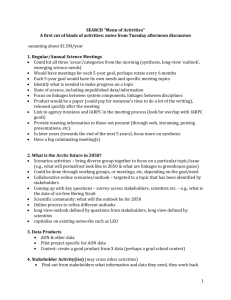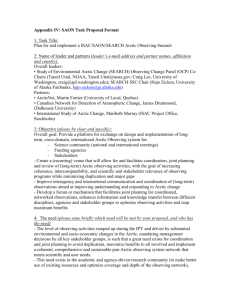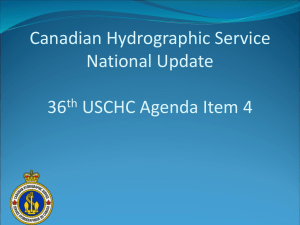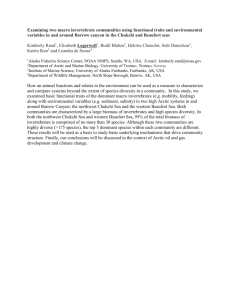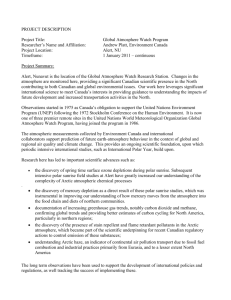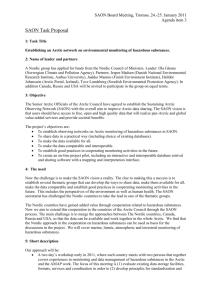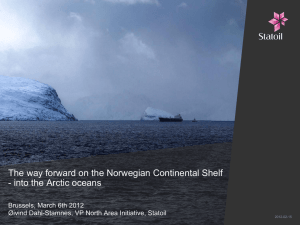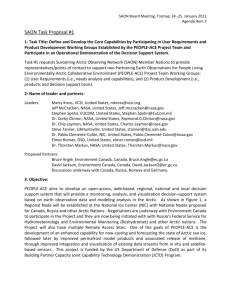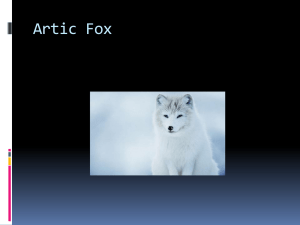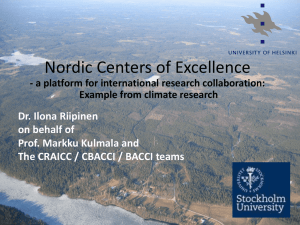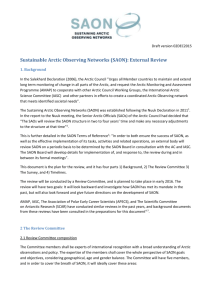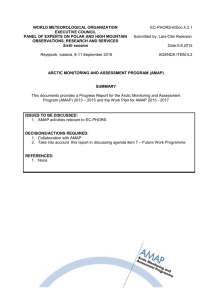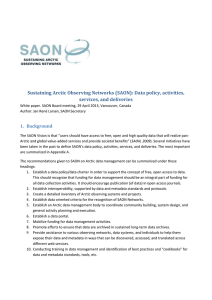International Arctic Systems for Observing the Atmosphere (IASOA)
advertisement
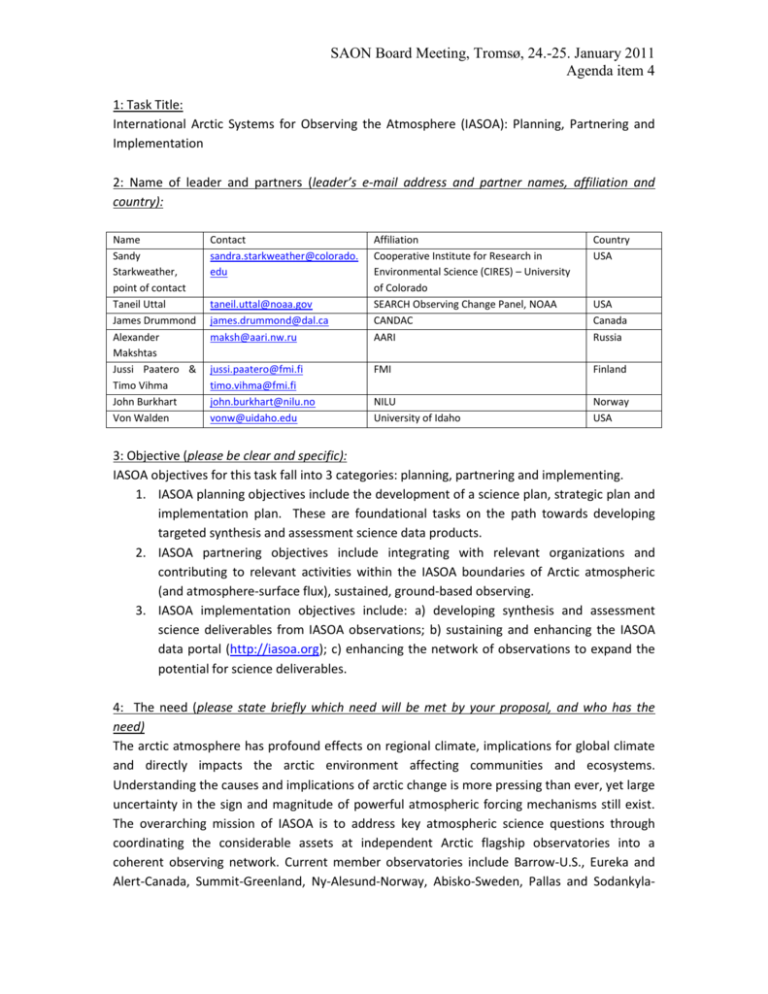
SAON Board Meeting, Tromsø, 24.-25. January 2011 Agenda item 4 1: Task Title: International Arctic Systems for Observing the Atmosphere (IASOA): Planning, Partnering and Implementation 2: Name of leader and partners (leader’s e-mail address and partner names, affiliation and country): Name Sandy Starkweather, point of contact Taneil Uttal James Drummond Alexander Makshtas Jussi Paatero & Timo Vihma John Burkhart Von Walden Contact sandra.starkweather@colorado. edu taneil.uttal@noaa.gov james.drummond@dal.ca maksh@aari.nw.ru jussi.paatero@fmi.fi timo.vihma@fmi.fi john.burkhart@nilu.no vonw@uidaho.edu Affiliation Cooperative Institute for Research in Environmental Science (CIRES) – University of Colorado SEARCH Observing Change Panel, NOAA CANDAC AARI Country USA FMI Finland NILU University of Idaho Norway USA USA Canada Russia 3: Objective (please be clear and specific): IASOA objectives for this task fall into 3 categories: planning, partnering and implementing. 1. IASOA planning objectives include the development of a science plan, strategic plan and implementation plan. These are foundational tasks on the path towards developing targeted synthesis and assessment science data products. 2. IASOA partnering objectives include integrating with relevant organizations and contributing to relevant activities within the IASOA boundaries of Arctic atmospheric (and atmosphere-surface flux), sustained, ground-based observing. 3. IASOA implementation objectives include: a) developing synthesis and assessment science deliverables from IASOA observations; b) sustaining and enhancing the IASOA data portal (http://iasoa.org); c) enhancing the network of observations to expand the potential for science deliverables. 4: The need (please state briefly which need will be met by your proposal, and who has the need) The arctic atmosphere has profound effects on regional climate, implications for global climate and directly impacts the arctic environment affecting communities and ecosystems. Understanding the causes and implications of arctic change is more pressing than ever, yet large uncertainty in the sign and magnitude of powerful atmospheric forcing mechanisms still exist. The overarching mission of IASOA is to address key atmospheric science questions through coordinating the considerable assets at independent Arctic flagship observatories into a coherent observing network. Current member observatories include Barrow-U.S., Eureka and Alert-Canada, Summit-Greenland, Ny-Alesund-Norway, Abisko-Sweden, Pallas and Sodankyla- SAON Board Meeting, Tromsø, 24.-25. January 2011 Agenda item 4 Finland, Tiksi and Cherski-Russia, Arctic Drifting Station-Russia. Observatories in this context are defined as facilities that support both standard meteorological measurements and collect data to support process-level studies, each features extensive suites of co-located, research grade active, passive and in-situ observing systems. The IASOA consortium represents a considerable contribution towards SAON for sustained, ground-based atmospheric observing. The consortium has been guided by key science questions related to the role of the Arctic atmosphere and its interactive elements (aerosols, clouds, gases) in forcing the pan-arctic surface energy balance and influencing other elements (marine, cryospheric and terrestrial) of the Arctic environment. The IASOA consortium has developed considerable data to address these questions, which are ready for synthesis. The planning proposed through this task will support such synthesis activities and create a framework whereby transformative progress towards updated questions will be expressed as a series of measureable activities organized for international participation. Framing ambitious synthesis science and assessment activities will improve understanding of arctic change beyond what can be accomplished by individual investigators and regionally uncoordinated approaches. Within the science community, syntheses will contribute to a focused understanding of physical processes, to better inform future research. For the broader community of stakeholders, targeted assessment and data products will contribute to more resilient Arctic communities and ecosystems. IASOA will pursue best practices to identify the contextual factors that will promote usability of IASOA data and information to a wider collection of stakeholders and contribute to SEARCH and ISAC Responding to Change activities. Further, IASOA will identify the intrinsic limitations of the existing network (e.g. spatial coverage, instrument gaps) and recommend prioritized expansion of network infrastructure. Through its website and data portal, these efforts will provide the science community and general public with a user-friendly and informative resource. The IASOA consortium provides a pan-arctic set of facilities that could be coordinated with the Association of Polar Early Career Scientists (APECS) and other education initiatives to develop unique curricula that would enrich future observatory operators and observational scientists. 5: Short description (please limit to one page, use attachment if strictly needed): The IASOA Science Plan will update key science questions and define a framework of experimental approaches that address those questions. Many relevant organizations have already developed science plans and questions that address atmospheric observing. IASOA will abstract relevant foci from these science plans: ISAC Science Plan; Study of Arctic Change (SEARCH) Science Plan; Tiksi Science Plan; Canadian Network for the Detection of Atmospheric Change (CANDAC) foundation documents; Summit Station White Paper; U.S. Department of Energy (DOE) Atmospheric System Research (ASR) Program Science Plan and more. The IASOA Strategic Plan will develop an updated mission statement supported by measurable goals. The endorsed and completed Strategic Plan will be published and distributed to sponsoring agencies, promoted at science meetings and posted on the IASOA website. SAON Board Meeting, Tromsø, 24.-25. January 2011 Agenda item 4 The Work Plan will detail a list of prioritized activities with a clear structure for international participation designed to meet the Strategic Plan goals and answer Science Plan questions. The steering committee will recommend activities that member observatories, sponsoring organizations or investigators can address through proposals and investments. Work planning will also include substantial implementation support to initiate working groups and guide them towards value-add science outcomes. The IASOA partnering process will identify and develop mechanisms for initiating and contributing to international activities, including: IASC-AWG: IASOA could benefit from IASC’s broad view of arctic atmospheres (including satellite and campaign work) and its ability to sponsor dynamic workshops with other disciplines and globally focused organizations like WCRP and WMO. IASC-AWG could look to IASOA to contribute observational and regional expertise to science foci. ISAC: IASOA would benefit from the strong international and interdisciplinary framework of the ISAC science plan. By reframing and endorsing IASOA relevant ISAC science questions, IASOA could provide ISAC with an excellent framework for recommending responsive activities through its science and work planning activities. AMAP: Many IASOA observatories are already AMAP observatories. AMAP synthesis science reports reach in to communities of experts for input and data. The IASOA consortium would be an excellent resource to AMAP for both. As IASOA focuses on high-impact data products, it would gain great insight into stakeholder relevant assessments through peer learning with AMAP. Contribute to WMO ECPORS activities like Global Integrated Polar Predication system (GIPPS) and Global Climate Watch (GCW) to maximally leverage IASOA observatory potential to act as GCW interdisciplinary “super sites”. Partner with relevant surface processes groups to develop an Arctic Flux Net program starting at IASOA member observatories to increase the value of these sites without increasing investments. Barrow and Ny-Alesund are already INTERACT sites. SIOS another other ESFRI projects, such as the Integrated Carbon Observing System (ICOS) and Aerosols, Clouds and Trace gases Research InfraStructure network (ACTRIS) also present many opportunities for strategic infrastructure partnerships. 6: Funding (estimated budget and likely funding sources): - Participation in IASOA Steering Committee activities supported by affiliated institutes - Sustaining observatory observations supported by affiliated institutes - 750,000 USD: Proposed planning support anticipated from the following U.S. agencies: NSF and NOAA - Workshop support from international partners (i.e. IASC-AWG) is in the early exploration stages SAON Board Meeting, Tromsø, 24.-25. January 2011 Agenda item 4 7: Time line (start and ending): Q1-2012 Steering Committee Formation Q22012 Q32012 Q42012 Q12013 Q22013 Q32013 Q42013 Q32015 Q42015 Complete Science Plan Strategic Plan Draft Draft Complete Complete Work Plan Publish Publish Develop, Complete, Publish Synthesis & Assessment Development Framing, Initiating Web & Data Portal On-Going Q12014 Q22014 Q32014 Q42014 Q12015 Q22015 Steering Committee Formation Science Plan Strategic Plan Work Plan Synthesis & Assessment Development Develop, Complete, Publish Web & Data Portal On-Going 8: Expected outcome/product: 1. A Science Plan: Updated science questions and a framework of experimental approaches that address those questions 2. A Strategic Plan: An updated mission statement supported by measurable goals 3. A Work Plan: A detailed list of prioritized activities with a clear structure for international participation designed to meet the Strategic Plan goals and answer Science Plan questions. Work planning will also include substantial implementation support to initiate value-add science outcomes. 4. An Enhanced Web and Data Portal to support the data sharing needs of the science community and the informational needs of the broader community of stakeholders SAON Board Meeting, Tromsø, 24.-25. January 2011 Agenda item 4 5. Significant partnerships identified. 6. Development of synthesis and assessment science reports. Contributions to existing activities like the Arctic Report Card and SWIPA. 7. Observational capacity building to strategically fill gaps identified during the synthesis and assessment framing process.

